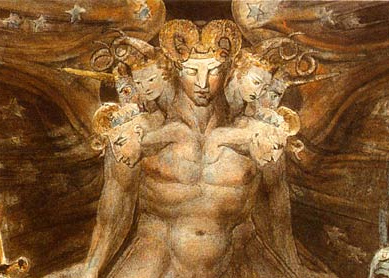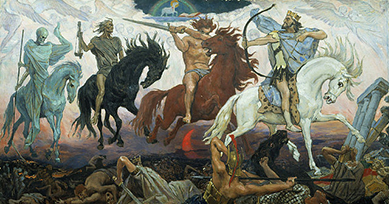In every century since New Testament times, Christians have been convinced that they are living in the last days. Some theologians, notably Augustine of Hippo (354-430), sought to spiritualize the Revelation of John or downplay its eschatological immediacy. Modern liberal Christians are also less likely to interpret biblical allusions to the end of time literally. But the vast majority of Christians throughout history have believed that the Revelation of John and the other apocalyptic books of the Bible reveal the imminent end of the present age and the dawning of the age to come.
For many, the expectation of the end carries consolation and hope in the promise of impending salvation from persecution or oppression, and even the menace of death. For this reason, the apocalyptic worldview often appeals to socially marginal groups that understand themselves to be in conflict with the powers of the world. But apocalypticism can also serve as the voice of large, stakeholder populations such as churches and states, which have linked their destinies with a divine plan or feel threatened by enemies external or internal.
For reasons that are not fully clear, Christian apocalypticists in the three centuries after Revelation were concerned more with visions of heaven and hell, although the end of history was always in sight. By the fifth century, however, doomsday prediction returned as the dominant mode of apocalyptic speculation in both the Byzantine East and the Latin West. Medieval life, literature, and art were thoroughly informed by the expectation of the imminent end of the world. Then as now, the terminal date was usually calculated by correlating the information in the visions of Daniel and John with contemporary figures and events. But Christians throughout the Middle Ages also composed hundreds of new apocalyptic texts, such as the Revelations of Pseudo-Methodius, while Joachim of Fiore and others proposed novel ways to construe history in light of the biblical data.
Apocalyptic expectation in Christianity continued unabated during the waning of the Middle Ages and throughout the Renaissance and Reformation. It fueled the rise of the radical millenarian movements of the age, such as the Taborites, and was a common feature of the religious conflicts that ravaged Europe and were later exported to the New World. In the eighteenth and nineteenth centuries, apocalyptic speculation acquired a new dimension via Protestant evangelicalism in the form of dispensationalist theology with a sharp accent on millennialism.
Modernity shaped apocalypticism profoundly. In its secular manifestations, the apocalyptic worldview has influenced political ideologies and the public perception of the state of the economy and the environment, and it has become a staple of mass popular culture. Meanwhile, traditional apocalyptic speculation is now associated with fundamentalism, new religious movements, contemporary evangelicalism, and a resurgence of Christianity in the third world. The close of the twentieth century witnessed the development of a “superflat” form of apocalyptic speculation—synthetic, syncretistic, and shallow—which reflects the spread of the worldview across an electronically interconnected planet and the substitution of spirituality for theology among a large percentage of Christians today.
Bibliography
- Weber, Eugen. Apocalypses: Prophecies, Cults, and Millennial Beliefs through the Ages. Cambridge, MA: Harvard University Press, 1999.
- Collins, John J., Bernard McGinn, and Stephen J. Stein, eds. The Encyclopedia of Apocalypticism. 3 vols. New York: Continuum, 1998.
- Rowland, Christopher, and Kovacs, Judith. Revelation: The Apocalypse of Jesus Christ. Malden, MA: Blackwell, 2004.




